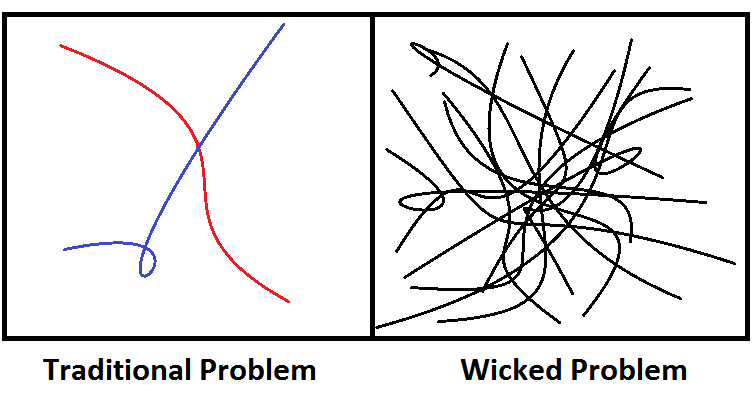Wicked Problems
Experiential Education

Objectives: What you will learn
- What a Wicked Problem is
- What makes a problem 'Wicked'
- Why try to solve wicked problems
- Some strategies to tackle wicked problems

Introduction
As part of the Associate Degree programs at the University College, you will most likely undertake a learning activity that involves a wicked problem. Wicked problems are not just problems in the traditional sense of being difficult, but they are highly complex and deemed almost impossible to solve. They often can, however, be managed. Working with wicked problems requires a range of skills and capabilities that, once learnt, will be of benefit to you both personally and professionally. Wicked problems require collaborative and creative approaches and thinking. You are not expected to solve these problems, but to work collaboratively with others to present possible responses and strategies that may lessen the impact of the problem.

What is a Wicked Problem?
We are surrounded by wicked problems on a local, national and global level. A wicked problem is a social or cultural problem that is highly complicated and nearly impossible to solve. These problems are not just considered ‘wicked’ because they are difficult, but because traditional thinking and processes can’t solve them (Kolko 2012).
The term ‘wicked’ in this context is used, not in the sense of evil, but rather as an issue highly resistant to resolution.

Some examples of wicked problems include:
- Poverty
- Cybersecurity
- Terrorism
- Inequality
- Climate change
As you can see in the list above, wicked problems (and many more not mentioned) cannot be solved easily, if at all. In fact, one of the reasons that make these problems ‘wicked’ is that they are often interrelated with other problems. For example, social inequality, conflict and political instabilities influence poverty. Often when one problem is ‘solved’ another is created. More on these complexities in the following sections.
What exactly makes a problem 'Wicked'?
Rittel and Weber first coined the term 'wicked problem' in 1973 and the characteristics they identified then have not changed significantly today. They include the characteristics that wicked problems:
- Have poor or contradictory information
- Are difficult to define, highly ambiguous and multi-causal
- Involve a large number of people with differing values and priorities
- Involve economic factors and burdens that influence the outcomes
- Interconnect with other wicked problems; that is, often when one wicked problem has been solved, another has been created
- Have solutions that are either ‘good’ or ‘bad’, not 'right' or 'wrong’
- Have solutions that usually involve changing behaviours
(Rittel & Weber 1973; Camillus 2008)
Weber and Khademiam (2008) define wicked problems as ‘unstructured, cross-cutting and relentless’.
Watch this video clip below which explains wicked problems in more detail:
Wicked Problems | 1:07
Why Try?
If wicked problems are so complex, if not impossible to solve, why bother trying?
One answer that might be fairly obvious would be: To help make the world a better place for those directly concerned, and for everyone else as well. Even though wicked problems might be difficult to solve and the solutions can create new problems, it is worth trying to solve them.
For example, Kolko (2012) suggests that many of the negative consequences of wicked problems can be mitigated. This means, for example, that the levels of global poverty might be reduced (even if not eradicated), which then might flow on to a lessening of disease and pandemics.
According to a policy paper on tackling wicked problems, ‘developing effective ways to tackle wicked problems is an evolving art’ (Commonwealth of Australia 2007, p. 1). This would indicate that although difficult to solve, wicked problems are worth tackling, and we as a society are finding better ways to tackle them, through the process of trying to tackle them. Every time there is a success, even a small one, we are moving closer as a society to some of the answers.
Never doubt that a small group of people can change the world

Strategies to Tackle Wicked Problems
Make the Unthinkable Thinkable
There are several strategies that can be put in place to try to tackle wicked problems.
One approach to tackling wicked problems is through design thinking strategies (Kolko 2012). Design thinking can be defined as an analytic and creative process that is collaborative, and benefits greatly from the multiple perspectives and others' creativity to problem solve.
For more information on design thinking refer to the P&P module Design Thinking
Some other strategies that have been employed to mitigate wicked problems are to:
- Involve many people in the problem-solving process; collaboration is critical
- Deconstruct and analyse the problem from all angles and perspectives
- Use ‘agile thinking’. That is, looking at both the big picture and also at all the small scale solutions
- Be open to alternative ways of thinking
- Look at the potential behaviour that is linked to the problem
- Focus on manageable, incremental actions
- Allow for continuous feedback and re-evaluation; adopt a feed-forward attitude
- Persevere
(Camillus 2008; Michigan State University 2016; Wong 2018)
We can’t solve the same problems by using the same kind of thinking we used when we created them.
Tools for Wicked Problems
Here are some tools that might help with creating strategies to deal with wicked problems:
What are some of the behaviours that might need changing to help solve wicked problems?
If you go back in this module and have a look at the typical characteristics of wicked problems, you will see that the last one (though by no means the least one) is that solutions will most likely involve a change of behaviours. That means a change in what we do, how we do it, and our attitude to the process: as societies, as corporations, as governments, and as individuals.
The skills, behaviours and attributes needed to solve challenging problems are many and varied. They include, but are not limited to:
- Teamwork and collaboration with a diverse range of people with differing perspectives and values
- Active listening skills
- Empathy and ethics
- Facilitation and mediation skills
- Problem-solving skills
- Agile and creative thinking
- Organisation and time management
- Reflective practice
(Michigan State University 2016)
One of the benefits of working with wicked problems is that as we progress, we are learning or developing these skills, behaviours and attributes (which are, of course, all transferable skills; that is, they are skills that can be applied in many other situations).

Conclusion
The recap:
- Wicked problems are social and cultural problems that can occur at the local, national, or global level.
- They are often interrelated with other wicked problems.
- They are highly complex and deemed almost impossible to solve.
- Tackling the problems is worth doing, for the benefit of those concerned and for global society as a whole.
- Tackling wicked problems is an evolving process, and our capacity to deal with them will improve as we practise.
- There are some strategies available that can help to tackle wicked problems.
- There are some tools available to help us formulate strategies.
- One major requirement for tackling wicked problems is a change in social and cultural attitudes and behaviours.
- The skills, attitudes and behaviours that can be learnt or developed during the process of trying to solve wicked problems are also skills, attitudes and behaviours that can help us in other areas of our lives; that is, they are transferable.
Activity
The transferable skills that you can gain from working with wicked problems are numerous. Complete the following Professional Competencies Skills Audit to see where your strengths are and what areas may need further development:
Reference List
Camillus, J 2008, ‘Strategy as a wicked problem’, Harvard Business Review, vol. 86, no. 5, pp. 98-106.
Commonwealth of Australia 2007, Tackling wicked problems: a public policy perspective, Australian Public Service Commission, viewed 6 June 2018, <http://www.enablingchange.com.au/wickedproblems.pdf>.
Complexity Labs 2018, Wicked problems, YouTube video, viewed 6 June 2018, <http://app.shorthand.com/export/5757f2ba02024aff9fc21d52b8e0d14e/index.html> .
Information Design 2014, Wicked Problems, YouTube video, viewed 9 September 2019, <Complexity Labs 2018, Wicked problems, YouTube video, viewed 6 June 2018, <http://app.shorthand.com/export/5757f2ba02024aff9fc21d52b8e0d14e/index.html>.
Kolko, J 2012, ‘Wicked problems: problems worth solving’, Stanford Social Innovation Review (book excerpt), viewed 6 June 2018, <https://ssir.org/articles/entry/wicked_problems_problems_worth_solving> .
Michigan State University, 2016, Engaging students in wicked problems: strategies for inspiring and preparing students to tackle messy, place-based challenges, webinar, viewed 23 May 2018, <https://mediaspace.msu.edu/media/Engaging+Students+in+Wicked+ProblemsA+Strategies+for+inspiring+and+preparing+students+to+tackle+messy%2C+place-based+challenges/1_rhy1zezs>.
Rittel, HW & Weber, MM 1973, ‘Dilemmas in a general theory of planning’, Policy Sciences, vol. 4 no. 2, pp. 155-69.
Weber, EP & Khademian, AM 2008, ‘Wicked problems, knowledge challenges, and collaborative capacity builders in network settings’ Public Administration Review, vol. 68 no. 2, pp. 334-49.
Wong, E 2018, ‘Wicked problems: 5 steps to help you tackle wicked problems by combining systems thinking with agile methodology’, The Interaction Design Foundation, viewed 30 May 2018 <https://www.interaction-design.org/literature/article/wicked-problems-5-steps-to-help-you-tackle-wicked-problems-by-combining-systems-thinking-with-agile-methodology>.

